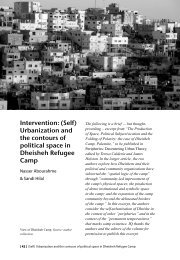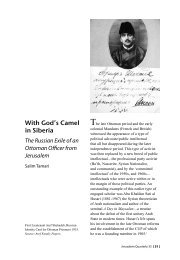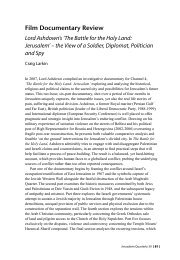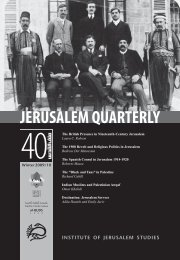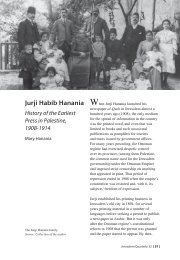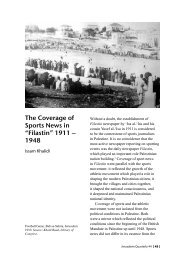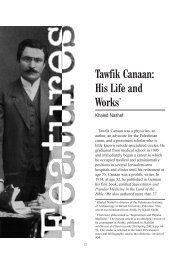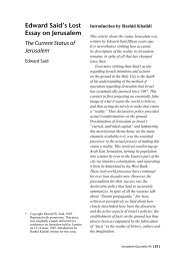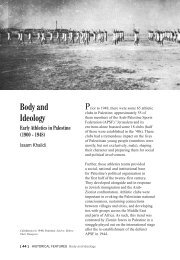PLUNDERING PALESTINE - Jerusalem Quarterly
PLUNDERING PALESTINE - Jerusalem Quarterly
PLUNDERING PALESTINE - Jerusalem Quarterly
You also want an ePaper? Increase the reach of your titles
YUMPU automatically turns print PDFs into web optimized ePapers that Google loves.
course of the Wall. “It’s all ours,” they explained, waving their hands over the land and<br />
what lay beneath it. 1<br />
When the Men in Black declared “It’s all ours,” they were in violation of international<br />
law (particularly the Fourth Geneva Convention) but nonetheless operating within the<br />
bounds of a certain kind of Israeli legality. In an important new book, Eyal Weizman<br />
points out that “on the same day that Arab <strong>Jerusalem</strong> and the area around it was<br />
annexed to Israel, the Israeli government declared the archaeological and historical<br />
sites in the West Bank, primarily those of Jewish or Israelite cultural relevance, to be<br />
the state’s ‘national and cultural property’, amounting to de facto annexation of the<br />
ground beneath the Occupied Territories, making it the first zone to be colonized.” 2<br />
The manner in which Israeli law undergirds illegal activity in this colonized zone–and<br />
the destruction of the non-renewable resource of the cultural heritage of Palestine–<br />
concerns a number of authors in this special issue of <strong>Jerusalem</strong> <strong>Quarterly</strong>. New<br />
opportunities for archaeological looting provided by the construction of the Wall are<br />
carried out by agents of the Israeli state, and accompany the “matrix of control” (Jeff<br />
Halper’s phrase) represented by the Wall. Similarly, the construction of Road 6, whose<br />
north-south course also produces more annexation of West Bank land, was accompanied<br />
by Israeli ‘salvage archaeology’ that yielded a range of “material objects…sherds and<br />
ceramics and an extensive cemetery…variously attributed to periods ranging from the<br />
Iron Age, Persian, Hellenistic and Early Roman to late Byzantine.” 3<br />
In his article in this volume, Adel Yahya notes that about 1,500 archaeological sites are<br />
isolated between the Wall (in its western course) and the Green Line, including over<br />
250 ‘high potential’ sites–a tempting array indeed for Israel’s ‘salvage’ operations.<br />
These state operations are joined on the other side of the Wall by what Adel Yahya<br />
calls Palestinian ‘subsistence looters’, driven by poverty and enabled by the lack<br />
of Palestinian security and enforcement. Palestinians “looting in their backyard”<br />
are integrated into Israel’s ‘legal’ market of antiquities, where Yahya estimates they<br />
receive perhaps 1% of the value of the objects they offer.<br />
Like Morag Kersel in this volume, Yahya opposes the legal trade in antiquities–both<br />
in Israel and Palestine–as a course that leads both to illegal looting and the destruction<br />
of a cultural heritage that belongs to all. Kersel offers a carefully-considered review of<br />
“the historical antecedents, the current practice, and the future initiatives” of cultural<br />
heritage law and the trade in antiquities, including Ottoman, Mandate and current<br />
Israeli legislation. While noting the inequities in the interim (Oslo) agreements,<br />
where Palestine is obligated to safeguard archaeological sites but there is no Israeli<br />
reciprocity, Kersel examines the Palestinian Draft Cultural and Natural Heritage Law<br />
2003 and cautions that confirming a legal trade in antiquities may further endanger a<br />
heritage already in peril. The <strong>Jerusalem</strong> <strong>Quarterly</strong> would welcome interventions on<br />
this critical question from its readers.<br />
[ 4 ] EDITORIAL Why are Those Men in Black Camping Near the Wall?



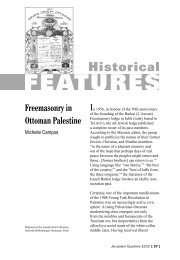
![In Search of Jerusalem Airport [pdf] - Jerusalem Quarterly](https://img.yumpu.com/49007736/1/180x260/in-search-of-jerusalem-airport-pdf-jerusalem-quarterly.jpg?quality=85)
